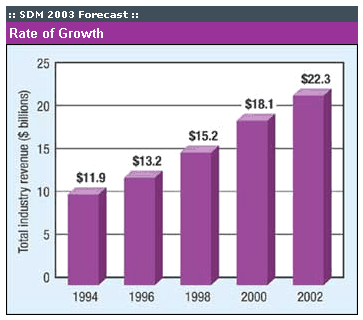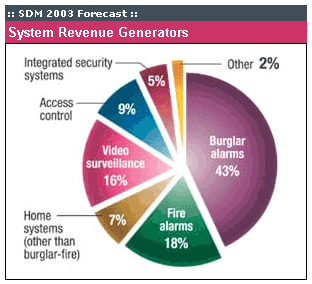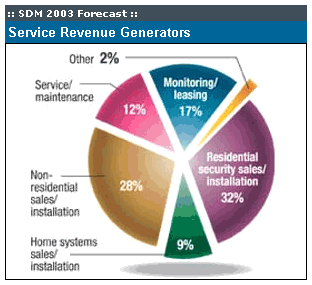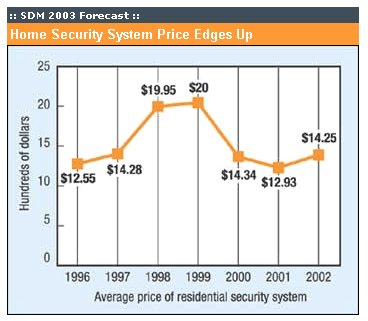
Due to the need for increased protection of our country’s public facilities, technology upgrades to existing security systems, and the relatively good housing market -- security dealers and systems integrators managed to grow the security industry 9.7 percent last year (on adjusted 2001 industry revenue of $20.4 billion).
Dealers and integrators are ever tenacious – thriving on here-and-now opportunities such as legislative-mandated security and consumers’ thirst for the latest home technologies. They even added a trickle of new staff in 2002. Their tenacity and quick-footedness allowed the 14,000 or so electronic security businesses to tap into a $22.4 billion market for products and services in 2002. (Note that this figure may be adjusted at a later date due to anticipated restating of revenues by some firms.)
“There are pockets of strength,†states Tom Patterson, putting it best. Patterson is managing partner of Kimberlite Corp., Fresno, Calif., which owns and operates several Sonitrol franchises in California. Patterson says Kimberlite’s sales are up substantially year-over-year, but that, naturally, some markets are performing better than others. Take schools, for instance. They constitute about 20 percent of Kimberlite’s customer base.
“It’s been a challenging year, owing to the budget [shortfalls] of the schools, so that market has been relatively soft,†Patterson notes.
“We’re seeing some strengths in some of the government markets. FDA security guidelines were published last January that have driven an increased focus on security throughout the food chain – producers, processors, packagers and transporters,†he says.
The “pockets of strength†that Patterson and other dealers experienced in the market were evident in a variety of ways. For example, technology such as digital video recorders and access control systems drove a substantial amount of new growth. Certain vertical markets and geographical areas also were stronger than others.
Patterson points out that Kimberlite’s sales in California’s San Joaquin Valley were up 66 percent. “Driving that would be the experience of the sales force, and significant increases in both digital video and access control sales,†he says. During the same period “we’ve experienced some declines in some Bay area markets, owing to the fact that they were on fire in previous years – the dot-com boom, the whole tech retrenchment – and that is certainly impacting our business.â€
In some years, technology turns out to be a major driver of revenues, and 2002 was one of those years. It was marked by a substantial increase in sales for both digital video and access control systems, SDM’s subscribers say. In fact, DVR sales are said to be so strong that 2002 could be coined “The Year of the DVR.â€
“In terms of product appeal…both of those are having an impact post-Sept. 11,†Patterson says. We’re seeing video sales up 193 percent year-over-year, and access control up 58 percent year-over-year.â€
SDM’s 2003 Industry Forecast Study showed that 16 percent of total dealer/integrator revenues stemmed from video surveillance system sales in 2002.

“In 2002 our burg sales (we count CCTV in that burg category) are going to eclipse the fire sales, and fire sales have increased. We’re now balanced almost equally between the two,†says CEO, Rod Garner. “We’re almost becoming a specialty CCTV company. All the new installations have DVRs. All the clients have to do is experience the difference once and then their entire chain goes to DVRs.â€
“Pockets of strength†in some of the Mountain states may be partly responsible for Mountain Alarm’s tremendous growth last year. Garner also credits the perseverance of his staff in building robust relationships with clients.
“As we went into 2002, knowing we had no acquisitions to make and that we were in a mode to retire debt, we anticipated a flat or moderately growing year,†Garner says. “What surprised us was a growth rate of close to 30 percent, fueled from internally generated sales. The run rate we’ve experienced the last half of [2002] will put us close to $30 million in 2003, up from $22 million in 2002. We’re financing all that internally, so you know our margins have to be adequate, and we’re retiring debt.â€
Mountain Alarm also operates in Washington, Idaho, Colorado, Arizona, and Nevada. “The economic woes that have hit the country have not hit those markets,†Garner suggests.
Both Kimberlite Corp. and Mountain Alarm are two of the country’s largest security firms, ranking among the top 30 in the SDM 100. If growth were to be found in “pockets†last year, then were smaller firms, with theoretically fewer resources with which to chase opportunities, affected? Remarkably, small security companies demonstrated the ability to respond very quickly to the market’s conditions.

Something for Everyone
“Our business in the past was 75 percent residential, and we’re trying harder to get more of the access control, cameras, fire alarm systems, etc. It seems like a better profit margin,†says Patrick Nolan, president of Advantage Protection Systems in Corpus Christi, Texas.The company, which, employs 11 people, had a 15 percent increase in sales last year, Nolan says.
Nolan says even though his company is distancing itself from residential work, he still sees residential as a strong market because of the low interest rates driving new housing construction.
“Along with new housing, people are buying alarm systems. It’s still a strong market, because of the lower interest rates, and that has probably spurred some of the businesses to invest a little bit more in security, too.â€
Lower interest rates may be a factor in growth in the commercial market, but technology upgrades had a definite impact.
“Sales are up from [2001] and since mid-year [2002] they’ve been rather brisk,†says Charlie Saums, CEO and president of Security Support Services, Jackson, Miss. “We do major commercial work, and we still do mom-and-pop installation of burglar alarms. I think the effects of 9/11 have gotten down to this part of the country and businesses have allocated funds.
“On the commercial side, it seems to be very brisk right now. Card access and CCTV and integrated systems are becoming the norm now. With the advent of the digital recorder and mobile monitoring it’s really coming on strong.
“In the South we’re probably six months behind on the trends of the East Coast, and happy to be doing well in this economy,†Saums says.
Still, Saums says his company’s greatest challenge last year was the economy, and adapting to new technology in a slow economy is what makes winners. “You have to continue to meet the design challenges of the digital technology.â€
His company added two employees in 2002 — one in design and the other in installation. “We’re becoming much more technically oriented. It used to be that salesmen could design this stuff, but now you have to have a design team to approach it.†Saums relates a story about a recent access control and video surveillance project at a car dealership, in which Security Support Services was the highest bidder, and got the contract because the lower bidders “didn’t show a grasp on how to make these products all work together,†he says.
Where does Saums find his pockets of strength? “Hospitals and health care and infant protection — and access control, because everybody is locking their buildings up — as opposed to small burglar alarms. You can make real profit in those areas.â€
With a staff of seven, FD Security Systems, Katonah, N.Y., is on a similar course as Texas-based Advantage Protection Systems — creating more distance from the residential market.
“We’ve been busy enough with the larger, higher-profit-margin commercial/corporate type stuff,†says Don Fait, president of FD Security Systems. “I haven’t had the time or inclination to be beating my head against the competition in the residential business.â€
Fait says his company’s sales were up about 35 percent last year.

Fait noticed a lot of end-user attention on specific applications last year, such as computer rooms, server rooms, and data closets, as well as upgrades from analog to digital recording and from black and white to color cameras.
FD Security Systems’ pocket of strength is a niche — elevator security. It installs bi-floor access control, cameras to monitor the elevator cabs, and emergency communications. “That market has expanded considerably,†Fait says.
Fait’s biggest challenge in 2002 was keeping up with demand and getting projects completed on time. Although the firm had a net addition of two installers last year, its increase in sales has led to some inefficiencies. “One of the problems is being stretched so thin and having to sometimes pull a crew from one project to another to get them completed by deadline,†he says.

Right Time, Place?
Despite a movement by some dealers to leave behind the residential market in favor of commercial, an equally strong trend is dealers who are making greater inroads in residential. But it’s not the same home security market of past years. For these dealers, security plays just a small part in a larger low-voltage scene. And demand — driven by low interest rates, a decent housing market, and swelling Internet/broadband usage — is on the rise.“With broadband Internet becoming more and more available, and PCs going down in price, most of my residents will have more than one PC that needs to be on the Internet at one time. The networking of PCs for Internet use is contributing to the structured cabling business,†says Ron Edwards, owner of Edwards Enterprises, Bentonville, Ark.
Edwards, a one-man operation, says sales were up about 30 percent in 2002. “I also do home theaters, home automation, central vac — I really haven’t experienced a decline in any of them.â€
Edwards, who restarted his company in 2000 after selling a previous firm and finishing a non-compete contract, is satisfied that his profits are “where they need to be right now.â€
Although many dealers and integrators recorded higher sales in 2002, there were still hard-fought battles in the war for better profits.
Sales were up about 10 percent for Pope Security Systems, Conway, N.H., and the company added one new employee. Still, it experienced a profit decline because of the higher cost of doing business — specifically, insurance, says Bradley Gaudreault, owner.
“Insurance costs have gone up considerably so that kind of evened [profits] right out,†he says. Gaudreault attributes Pope Security’s revenue increase, however, to the economy.
“People are out of work and breaking into places. There’s been a lot of work in commercial fire jobs as well, and people needing to expand,†he says. “Some of it is the Sept. 11 stuff — water precincts and hazardous waste sites having to increase their security. There are a lot of second homes around this area and they’ve been requesting to install low-temperature alarms, water detectors, and fire protection,†Gaudreault says. “Everything seems just a little busier.â€
Some dealers hired extra staff, which also contributed to initially lower profits last year.
“Profits were probably not as good, because of additional employees. Gross, of course, was much bigger,†says Jack Gilbert, owner of Gilbert Security Systems, Van Buren, Ark. “But the bright side is I was able to pay the employees what I paid the government. We figured for what we were paying the government in taxes, we could hire two more people.â€
Hiring additional staff became necessary because the threat of terrorism motivated his clients to beef up security, Gilbert says. “Even though we’re in hillbilly Arkansas, 9/11 certainly had an effect.â€
Gilbert Security specializes in fire alarms and closed circuit video. One of the company’s recent projects was a nurse call system, cable TV and telephone wiring for a large assisted-care facility. “We’re finding that even large industrial [clients] want one source of low-voltage solutions.â€
Still, Gilbert’s toughest challenge in 2002 was financing growth. “We’re fairly small and so we had to learn how to get along with bankers and borrow a little money, because the bigger jobs are not going to pay until it’s signed off by the fire marshal,†Gilbert notes.
Financing was tough all over, especially because of ADT’s cut-back in subscriber purchases from its authorized dealers. Among dealers in general, only 7 percent made an acquisition in 2002. Among the SDM 100 ranking of the industry’s largest security firms, 36 percent completed acquisitions. If greater financing were available, the market could most likely support more acquisitions.
“The hardest struggle that we’ve had is having our revenues and sales stay at a high enough point that we can stay in existence,†says Barry Albert, owner of Integrated Security and Electronics, Rochester, N.Y. “Our revenues are up, but not as significant as the sales. We are not able to command the same amount of money that we once were.â€
Albert has owned his own business since 1999 and employs two people. He is looking ahead to possibly being acquired next year by a larger company with “financially more opportunities.â€

Competition & Pricing
It may be this squeeze on profits along with hard-to-find financing that are forcing dealers and integrators to realize that they must do a better job of pricing for profitability.The 2003 Forecast Study results showed that dealers earned a greater percentage of total revenue from sales and installation in 2002 than they did in 2001. The results also showed that the average price of a residential security system rose from $1,293 in 2001, to $1,425 in 2002. The average monthly monitoring fee increased from $22 in 2001 to $22.75 in 2002.
“I would hope that most of the people in the country are focusing on actually making a margin anymore. The days of having to give stuff away are gone, and those that are still doing it are screwing it up,†Garner says. “All the people who do that have suffered the whirlwind of gigantic attrition numbers.â€
Others agree.
“I’ve been told that ADT has…cut loose a bunch of dealers [interview conducted in early November], so independent dealers can sell quality systems at a profit rather than having to compete with give-away systems and limited security systems,†Saums says. “We slowed down in the residential market, because we refused to compete in the residential market. So now that ADT has backed out, it’s just like it used to be in the late ‘80s. I see it headed back that way.â€
Whether consumers will swallow higher prices when they’ve seen home security systems marketed for next to nothing for so long remains to be seen. Most likely dealers will need to add greater perceived value in order to truly profit.
SDM 2003 Forecast :: About SDM’s Forecast Study
The objective of SDM’s Forecast Study is to measure current year sales activity and product consumption, current-year revenues, business challenges and market opportunities, and other factors. The survey, conducted annually since 1982, was mailed to a random sample of 2,000 SDM subscribers with executive titles (installing dealers with and without central stations, systems integrators, access control systems specialists, and engineered fire systems distributors) during the week of Sept. 22, 2002. The number of usable replies at the cut-off date of October 25, 2002, netted a 16 percent response rate.At the same time, the same survey was mailed to the SDM 100 companies and Top Systems Integrators companies, separate groups of 100 each of the largest firms in the industry. The SDM 100 response rate was 28 percent, and the Top Systems Integrators response rate was 27 percent. Those results are reported separately where cited.
